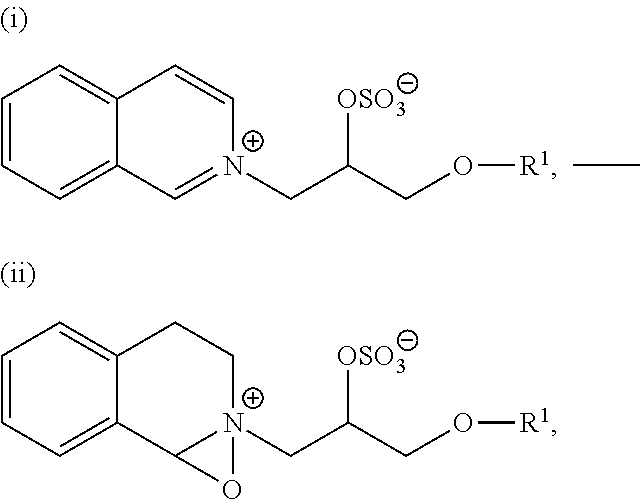Detergent Composition
a detergent composition and composition technology, applied in the field of detergents, can solve the problems of bacteria being a source of bad odor, difficult to remove soil by commercially available detergent compositions, and affecting the wash performance, so as to improve the wash performance, and improve the wash performance
- Summary
- Abstract
- Description
- Claims
- Application Information
AI Technical Summary
Benefits of technology
Problems solved by technology
Method used
Image
Examples
example 1
[0620]Cloning of the P34A9E DUF1524 Polypeptide Coding Sequence from Trichoderma harzianum O4
[0621]The P34A9E DUF1524 polypeptide coding sequence was cloned from Trichoderma harzianum O4 DNA by PCR.
[0622]Trichoderma harzianum O4 was cultivated in 100 ml of YP+2% glucose medium in 1000 ml Erlenmeyer shake flasks for 5 days at 20° C. Mycelia were harvested from the flasks by filtration of the medium through a Buchner vacuum funnel lined with MIRACLOTH® (EMD Millipore, Billerica, Mass., USA). Mycelia were frozen in liquid nitrogen and stored at −80 C until further use. Genomic DNA was isolated using a DNEASY® Plant Maxi Kit (QIAGEN GMBH, Hilden Germany) according to the manufacturer's instructions.
[0623]Genomic sequence information was generated by Illumina MySeq (Illumina Inc., San Diego, Calif.). 5 pgs of the isolated Trichoderma harzianum genomic DNA was used for library preparation and analysis according to the manufacturers instructions. A 300 bp, paired end strategy was employed ...
example 2
[0640]Characterization of the P34A9E DUF1524 Polypeptide Coding Sequence from Trichoderma harzianum O4
[0641]The genomic DNA sequence and deduced amino acid sequence of the Trichoderma harzianum O4 P34A9E DUF1524 polypeptide genomic coding sequence are shown in SEQ ID NO: 1 and SEQ ID NO: 2, respectively. The coding sequence is 867 bp including the stop codon, and three introns were observed at positions 76-154, 289-362 and 521-615 respectively. The encoded predicted protein is 205 amino acids. Using the SignalP program (Nielsen et al., 1997, supra), a signal peptide of 17 residues was predicted. The predicted mature protein contains 188 amino acids with a predicted molecular mass of 20 kDa and a predicted isoelectric point of 5.9. The discrepancy between the predicted molecular weight and the molecular weight predicted by SDS gel analysis (30 kDa) most likely is the result of glycosylation of the peptide.
[0642]A comparative pairwise global alignment of amino acid sequences was deter...
example 3
[0643]Deep-Cleaning Performance of Trichoderma harzianum DNase in Liquid and Powder Model Detergent
[0644]Isolating Laundry Specific Bacterial Strains
[0645]One strain of Brevundimonas sp. isolated from laundry was used in the present example. Brevundimonas sp. was pre-grown on Tryptone Soya Agar (TSA) (pH 7.3) (CM0131; Oxoid Ltd, Basingstoke, UK) for 2-5 days at 30° C. From a single colony, a loop-full was transferred to 10 mL of TSB and incubated for 16 hours at 30° C. with shaking (240 rpm). After propagation, Brevundimonas sp. was pelleted by centrifugation (Sigma Laboratory Centrifuge 6K15) (3000 g at 21° C. in 7 min) and resuspended in 10 mL of TSB diluted twice with milliQ water. Optical density (OD) at 600 nm was measured using a spectophometer (POLARstar Omega (BMG Labtech, Ortenberg, Germany). Fresh TSB diluted twice with milliQ water was inoculated to OD600 nm 0.03, and 1.6 mL was added into each well of a 12-well polystyrene flat-bottom microplate (3512; Corning Incorporat...
PUM
| Property | Measurement | Unit |
|---|---|---|
| Fraction | aaaaa | aaaaa |
| Fraction | aaaaa | aaaaa |
| Fraction | aaaaa | aaaaa |
Abstract
Description
Claims
Application Information
 Login to View More
Login to View More - R&D
- Intellectual Property
- Life Sciences
- Materials
- Tech Scout
- Unparalleled Data Quality
- Higher Quality Content
- 60% Fewer Hallucinations
Browse by: Latest US Patents, China's latest patents, Technical Efficacy Thesaurus, Application Domain, Technology Topic, Popular Technical Reports.
© 2025 PatSnap. All rights reserved.Legal|Privacy policy|Modern Slavery Act Transparency Statement|Sitemap|About US| Contact US: help@patsnap.com

